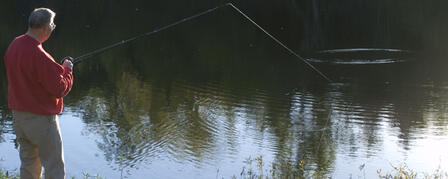2012 FISHING REGULATION SUMMARY NOW AVAILABLE

Jan. 12, 2012
Latest rules; how, where, and what to fish for; new bait restrictions included
PRATT — Printed copies of the 2012 Kansas Fishing Regulations Summary booklet are now available at Kansas Department of Wildlife, Parks and Tourism (KDWPT) office and license vendors, the agency has announced. Among other things, the publication lists new regulations that took effect Jan. 1. From new regulations regarding bait fish to new lakes and ice fishing regulations, the booklet has everything the angler needs to begin the New Year right.
The following information details Kansas fishing regulation changes for 2012:
ANS-designated Waters
Aquatic Nuisance Species (ANS) waters are defined as waters containing the prohibited species Asian carp, white perch, and/or zebra mussels. Fish may not be transported alive from ANS-designated waters.
Zebra mussels were found in Council Grove, Kanopolis, and Melvern reservoirs, as well as both Jeffery Energy Center lakes last year, bringing the total number of infested lakes to 15.
Bait
Wild-caught bait fish shall only be used on the body of water where taken. If taken on a flowing stream or river, wild-caught bait fish shall not be transported upstream across any dam or natural barrier.
New regulations have been passed regarding what bait dealers may legally sell. Among the restrictions are that certain fish and crayfish and amphibians may no longer be sold for bait. For details, contact a local natural resource officer, fisheries biologist, or KDWPT?office.
New Lakes
Critzer Reservoir, near Mound City, was opened to fishing last spring. And ponds on the Grand Osage Wildlife Area, near Parsons, may be opened for fishing in 2012.
Transporting Fish/Bilges and Livewells
Stocking or releasing of wildlife on navigable publicly-owned rivers and federal reservoirs and department lands and waters is prohibited.
Livewells and bilges must be drained and drain plugs removed from all vessels prior to transport from any waters of the state on a public highway.
No person may possess any live fish upon departure from any designated aquatic nuisance body of water.
Trout
Opening day of trout season for 2012 will be Nov. 1. Colby Villa High Lake has been added to the Type 1 list of waters stocked with trout.
Ice Fishing
Motorized electric or gasoline-powered two-wheeled vehicles, all-terrain vehicles, work-site utility vehicles, golf carts, and snowmobiles may be operated on ice-covered department waters only for the purpose of ice fishing from one-half hour before sunrise to one-half hour after sunset. These vehicles shall enter onto the ice only from boat ramps and points of entry as established by posted notice.
The 2012 booklet also features state park and cabin information and detailed regulations for each body of water managed by KDWPT.
In addition, a full-color fish identification guide lists all the state's sportfish, complete with text descriptions and detailed illustrations by renowned fish illustrator Joseph Tomelleri. Look-alike species are grouped together with complementary text to help the angler distinguish the difference between such closely-related species as white bass and wipers; blue catfish and channel catfish; the state's three black basses; black and white crappie; and pallid, shovelnose, and lake sturgeon.
The booklet also provides the latest information about aquatic nuisance species (ANS) in Kansas waters, including a complete listing of ANS waters by county. Three pages are dedicated to this subject, complete with detailed illustrations and tips on how to prevent the spread of ANS plants, mollusks, and fish.
Anglers who want to contact a district fisheries biologist will find a listing of names and phone numbers of the nearest biologist, as well as regional supervisors. A listing of natural resource officer contacts is also included.
For more information, contact the nearest KDWPT office, pick up a copy of the 2012 Kansas Fishing Regulations Summary wherever licenses are sold. Copies may also be downloaded from the KDWPT website, www.kdwpt.state.ks.us. Click the “Fishing” icon at the top of the page, then “Fishing Regulations” in the left-hand column.
-30-







